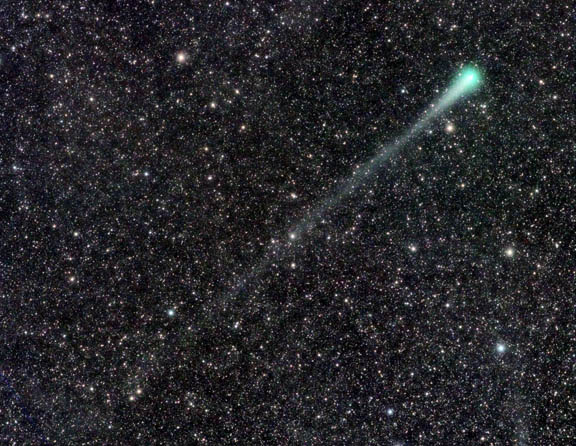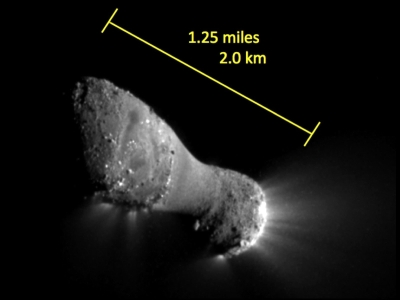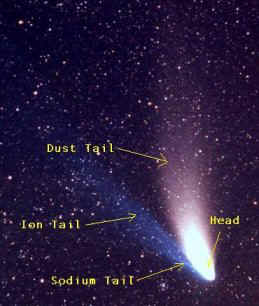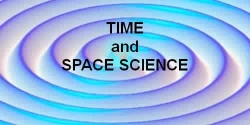Comets
Comets

Nucleus
Coma or the Head
Types of Tails
Type I Tail (Ionic or Plasma Tail)
Type II Tail (Dust Tail)
Sodium Tail
What is a nucleus?
The nucleus is a compact body of irregular form with a diameter between 1 and 100 km (from 40 to 50 km for Hale-Bopp). However it is not visible from the Earth. The American astronomer Fred Whipple proposed the " dirty snow ball " model: the nucleus is a solid amalgam of ices and dust which sublimates when it approaches the Sun.
Sublimation begins at 15 AU from the Sun. The spectroscopic analysis shows that the ensuing gases appear in the order of their temperature of sublimation. The model also explains the so-called non-gravitational forces as being due to the ejection of gas jets (cfr infra). A final confirmation was provided by the probe Giotto which took a close up (18 000 km) photograph showing the nucleus of Halley's comet in March 1986.
How do we know the size of the nucleus?
Although in most cases one cannot observe the nucleus directly, its diameter can be determined either by radar echo or by the albedo method.
The first method is based on the precise determination of a return trip of a radar pulse. The returning echo from a sphere will be spread out over a time of the order of radius divided by the speed of light. Such observations also provide the period of revolution and the orientation of the axis of rotation from the Doppler shift of the return signal. Unfortunately, the comet Hale-Bopp passed too far from the Earth so that its nucleus cannot be studied in this way.
What is a coma?
Comets are small, fragile, irregularly shaped bodies composed of a mixture of non-volatile grains and frozen gases. They usually follow highly elongated paths around the Sun. Most become visible, even in telescopes, only when they get near enough to the Sun for the Sun's radiation to start subliming the volatile gases, which in turn blow away small bits of the solid material. These materials expand into an enormous escaping atmosphere called the coma, which becomes far bigger than a planet, and they are forced back into long tails of dust and gas by radiation and charged particles flowing from the Sun. Comets are cold bodies, and we see them only because the gases in their comae and tails fluoresce in sunlight (somewhat akin to a fluorescent light) and because of sunlight reflected from the solids.
Comets are regular members of the solar system family, gravitationally bound to the Sun. They are generally believed to be made of material, originally in the outer part of the solar system, that didn't get incorporated into the planets -- leftover debris, if you will. It is the very fact that they are thought to be composed of such unchanged "primitive" material that makes them extremely interesting to scientists who wish to learn about conditions during the earliest period of the solar system.
It is a very luminous halo which one observes all around the nucleus.

The nucleus of a comet, which is its solid, persisting part, has been called an icy conglomerate, a dirty snowball, and other colorful but even less accurate descriptions. Certainly a comet nucleus contains silicates akin to some ordinary Earth rocks in composition, probably mostly in very small grains and pieces. Perhaps the grains are "glued" together into larger pieces by the frozen gases.
A nucleus appears to include complex carbon compounds and perhaps some free carbon, which make it very black in color. Most notably, at least when young, it contains many frozen gases, the most common being ordinary water. In the low pressure conditions of space, water sublimes, that is, it goes directly from solid to gas -- just like dry ice does on Earth. Water probably makes up 75-80% of the volatile material in most comets.
Other common ices are carbon monoxide (CO), carbon dioxide (CO2), methane (CH4), ammonia (NH3), and formaldehyde (H2CO). Volatiles and solids appear to be fairly well mixed throughout the nucleus of a new comet approaching the Sun for the first time. As a comet ages from many trips close to the Sun, there is evidence that it loses most of its ices, or at least those ices anywhere near the nucleus surface, and becomes just a very fragile old "rock" in appearance, indistinguishable at a distance from an asteroid.
A comet nucleus is small, so its gravitational pull is very weak. You could run and jump completely off of it (if you could get traction). The escape velocity is only about 1 m/s (compared to 11 km/s on Earth).
As a result, the escaping gases and the small solid particles (dust) that they drag with them never fall back to the nucleus surface. Radiation pressure, the pressure of sunlight, forces the dust particles back into a dust tail in the direction opposite to the Sun. A comet's tail can be tens of millions of kilometers in length when seen in the reflected sunlight. The gas molecules are torn apart by solar ultraviolet light, often losing electrons and becoming electrically charged fragments or ions.
The ions interact with the wind of charged particles flowing out from the Sun and are forced back into an ion tail, which again can extend for millions of kilometers in the direction opposite to the Sun. These ions can be seen as they fluoresce in sunlight.
It is about spherical with an average diameter of 200 000 km at 1 AU of the Sun (100 000 km for Hale-Bopp). Its size varies inversely with the square of the heliocentric distance.
Why is there a luminous halo?
Sublimation creates a gaseous environment that become excited under the influence of sunlight and of the protons from the solar wind. The ensuing fluorescence results from a subsequent transition of an electron between two energy levels.
Why does the coma vary in size?
Comets are very small in size relative to planets. Their average diameters usually range from 750 m or less to about 20 km. Recently, evidence has been found for much larger distant comets, perhaps having diameters of 300 km or more, but these sizes are still small compared to planets. Planets are usually more or less spherical in shape, usually bulging slightly at the equator. Comets are irregular in shape, with their longest dimension often twice the shortest. The best evidence suggests that comets are very fragile. Their tensile strength (the stress they can take without being pulled apart) appears to be only about 1,000 dynes/cm^2 (about 2 lb./ft.^2). You could take a big piece of cometary material and simply pull it in two with your bare hands, something like a poorly compacted snowball.
When the nucleus approaches the Sun, the condensed gases evaporate. As the temperature increases, so does the rate of sublimation and new species (which have a higher temperature of sublimation) are set free. So, the size of the coma increases when it approaches the Sun. The size of the coma can also vary from one comet to another depending upon the materials it is made of (because they have different temperatures of sublimation).
Types of Tails
Every comet then really has two tails, a dust tail and an ion tail. If the comet is faint, only one or neither tail may be detectable, and the comet may appear just as a fuzzy blob of light, even in a big telescope. The density of material in the coma and tails is very low, lower than the best vacuum that can be produced in most laboratories. In 1986 the Giotto spacecraft flew right through Comet Halley only a few hundred kilometers from the nucleus. Though the coma and tails of a comet may extend for tens of millions of kilometers and become easily visible to the naked eye in Earth's night sky, as Comet West's were in 1976, the entire phenomenon is the product of a tiny nucleus only a few kilometers across.

The ionic tail, known as type I or plasma
A plasma tail is made up of ions. This tail is straight and is always opposed to the direction of the Sun. It is up to 100 000 km wide and of a few tens of million km long. Blue is the colour which dominates its spectrum.
Why are there ions?
In order to understand that, it is important to know another phenomenon: solar wind. This is a wind of charged particles wound in an helix around the solar magnetic field. This wind moves at a speed of 400 km per s. The gases are ionised either by photoionisation of the neutral molecules under the action of the solar ultraviolet radiation, or under the action of the solar wind by a phenomenon where a proton removes an electron from an atom.
Why is it straight and opposed to the direction of the Sun?
The initial velocity of the ions is provided by the reaction that produced them. The ions are carried by the solar magnetic field at 10 to 100 km per s. The tail is thus straight on account of the speed of the ions, and forms an angle of a few degrees with direction of the Sun, in the direction opposed to the motion.
Where does the light come from?
It is emitted by fluorescence: a particle of solar wind excites an electron of the atom or molecule concerned. This electron reaches a metastable level, goes down again and releases its surplus energy in the form of a photon (particle of light) of a well determined energy and thus, of a specific colour.
Why is it blue?
The blue colour is explained by the fact that the most abundant ion, CO+ emits around 400 to 460 nm, in the blue part of the spectrum.
The Type II Tail
A Type II tail is the most spectacular part: it extends over several millions km and is made up of particles of dust whose size varies between 0.1 and 10 m m. It is very different from the ion tail. Although remaining in the plane of the orbit, the dust trails behind the motion of the comet giving this tail a curved appearance. The dominant colour of the dust tail is yellowish.
Why is dust accelerated in the direction opposite to the Sun?
The motion of the particles leaving the coma is influenced by forces external to the comet: the gravitational attraction of the Sun,
Fg = (where M is the mass of the Sun and m, that of dust),
and also a repelling force which will project them towards the tail; this force comes from the radiation pressure of the Sun (the photons communicate to the particles an impulse directed opposite to the Sun;
it is the pressure of radiation,
Fr = (where a = the radius of the particle; s r(a) = coefficient measuring the effectiveness of the radiation pressure; F = Solar constant; c = the speed of the light and r = the heliocentric distance).
The speed of the dust which makes it up is about 0.1 to a few km per s (much smaller than the orbital velocity of the comet around the Sun). Each grain of dust follows a slightly different ellipse leaving a curved trail.

Why is it of yellowish colour?
The dust is mainly made up of silicates (principal component of sand). This dust does not emit any light (like the ion tail does it by fluorescence) but only reflects that of the Sun (which is of a yellowish white).
The anomalous tail or anti-tail, is observed when the Earth is about in the plane of the cometary orbit; it is thus rather rare and of short duration. One then sees a tail pointing towards the Sun, hence its name. Such anti-tails were observed in the comets Arend-Roland (1957 III), Kohoutek (1973 XII) and Hale-Bopp (C/1995 O1).
Why does this tail point towards the Sun?
To explain the appearance of this tail, one can put forward two hypothesis:
1. It could be due to the accumulation of grains of large size (approximately 50 mm) which escape very slowly from the nucleus and would be emitted at a much earlier time. They need to be seen " on edge " so that the light that they diffuse is sufficient to simulate a tail.
2. It could be due to a visual effect where the curve of the tail of dust would
reveal a small point opposed to the principal tail. We think that the second hypothesis is more likely because the first one does not explain why the anti-tail is so narrow.
Physics
Comets, of course, must obey the same universal laws of motion as do all other bodies. Where the orbits of planets around the Sun are nearly circular, however, the orbits of comets are quite elongated. Nearly 100 known comets have periods (the time it takes them to make one complete trip around the Sun) five to seven Earth years in length. Their farthest point from the Sun (their aphelion) is near Jupiter's orbit, with the closest point (perihelion) being much nearer to Earth. A few comets like Halley have their aphelions beyond Neptune (which is six times as far from the Sun as Jupiter). Other comets come from much farther out yet, and it may take them thousands or even hundreds of thousands of years to make one complete orbit around the Sun. In all cases, if a comet approaches near to Jupiter, it is strongly attracted by the gravitational pull of that giant among planets, and its orbit is perturbed (changed), sometimes radically. This is part of what happened to Shoemaker-Levy 9.
Sodium Tail
As the image shows, its appearance is markedly different from the other
tails. It would be about 800 000 km broad and at least 12 000 000 km long.
It is observable only with a narrow band yellow filter because the
concentration of neutral sodium is very small. 
Is this the first time this phenomenon is observed?
No, it has already been observed during a few hours on certain comets with a perihelion lower than 0.05 AU. At that point, temperature is so high that metals like sodium can be ionised. Hale-Bopp however did not reach that close to the Sun, and its sodium tail is thus one of a kind.
Where does this tail come from?
We know that the neutral sodium is not directly emitted from the nucleus but is ejected from grains of sand from the tail of dust.
How is this tail formed?
That remains a mystery because the magnetic field cannot carry molecules or atoms which are not ionised and the pressure of radiation does not act on grains of diameter lower than 0.1 m m.
How was it discovered?
From spectroscopy carried out by satellites in 1970 hydrogen was discovered in the comets Tago-Sato-Kosaka and Bennett from the Lyman a line at 121.6 nm. Ionised hydrogen forms in fact an enormous halo (150 millions km for Hale-Bopp) which largely exceeds the limits of the coma.
Why isn't it not visible since the Earth?
Atomic hydrogen emits in the ultraviolet (l < 300 nm) but the ozone layer (O3) stop these wavelengths. The hydrogen cloud can only be observed from space, with satellites, for example. It is also for this reason that the hydrogen cloud was discovered so late.
Because comet nuclei are so small, they are quite difficult to study from Earth. They always appear at most as a point of light in even the largest telescope, if not lost completely in the glare of the coma. A great deal was learned when the European Space Agency, the Soviet Union, and the Japanese sent spacecraft to fly by Comet Halley in 1986. For the first time, actual images of an active nucleus were obtained and the composition of the dust and gases flowing from it was directly measured. The opportunity to reconstruct the events that occurred when Shoemaker-Levy 9 split and to study those that will occur when the fragments are destroyed in Jupiter's atmosphere is uniquely important.

